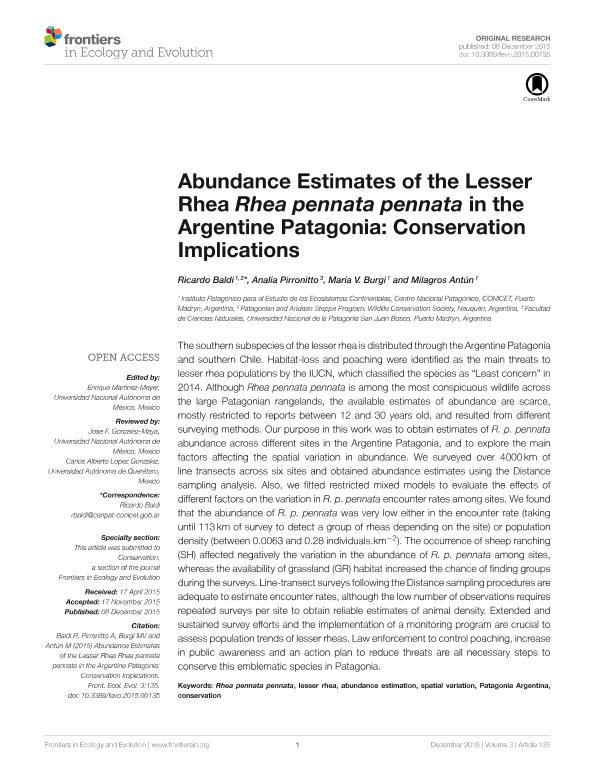Mostrar el registro sencillo del ítem
dc.contributor.author
Baldi, Ricardo

dc.contributor.author
Pirronitto, Analia
dc.contributor.author
Burgi, Maria Virginia

dc.contributor.author
Antun, Maria de Los Milagros

dc.date.available
2018-03-19T14:40:23Z
dc.date.issued
2015-12
dc.identifier.citation
Baldi, Ricardo; Pirronitto, Analia; Burgi, Maria Virginia; Antun, Maria de Los Milagros; Abundance estimates of the lesser rhea Rhea pennata pennata in the Argentine Patagonia: conservation implications; FRONTIERS IN ECOLOGY AND EVOLUTION; FRONTIERS; 3; 135; 12-2015; 1-8
dc.identifier.issn
2296-701X
dc.identifier.uri
http://hdl.handle.net/11336/39181
dc.description.abstract
The southern subspecies of the lesser rhea is distributed through the Argentine Patagonia and southern Chile. Habitat-loss and poaching were identified as the main threats to lesser rhea populations by the IUCN, which classified the species as "Least concern" in 2014. Although Rhea pennata pennata is among the most conspicuous wildlife across the large Patagonian rangelands, the available estimates of abundance are scarce, mostly restricted to reports between 12 and 30 years old, and resulted from different surveying methods. Our purpose in this work was to obtain estimates of R. p. pennata abundance across different sites in the Argentine Patagonia, and to explore the main factors affecting the spatial variation in abundance. We surveyed over 4000 km of line transects across six sites and obtained abundance estimates using the Distance sampling analysis. Also, we fitted restricted mixed models to evaluate the effects of different factors on the variation in R. p. pennata encounter rates among sites. We found that the abundance of R. p. pennata was very low either in the encounter rate (taking until 113 km of survey to detect a group of rheas depending on the site) or population density (between 0.0063 and 0.28 individuals.km−2). The occurrence of sheep ranching (SH) affected negatively the variation in the abundance of R. p. pennata among sites, whereas the availability of grassland (GR) habitat increased the chance of finding groups during the surveys. Line-transect surveys following the Distance sampling procedures are adequate to estimate encounter rates, although the low number of observations requiresrepeated surveys per site to obtain reliable estimates of animal density. Extended and sustained survey efforts and the implementation of a monitoring program are crucial to assess population trends of lesser rheas. Law enforcement to control poaching, increase in public awareness and an action plan to reduce threats are all necessary steps to conserve this emblematic species in Patagonia.
dc.format
application/pdf
dc.language.iso
eng
dc.publisher
FRONTIERS IN ECOLOGY AND EVOLUTION

dc.rights
info:eu-repo/semantics/openAccess
dc.rights.uri
https://creativecommons.org/licenses/by-nc-sa/2.5/ar/
dc.subject
Rhea Pennata Pennata
dc.subject
Lesser Rhea
dc.subject
Abundance Estimation
dc.subject
Spatial Variation
dc.subject
Patagonia Argentina
dc.subject
Conservation
dc.subject.classification
Otras Ciencias Biológicas

dc.subject.classification
Ciencias Biológicas

dc.subject.classification
CIENCIAS NATURALES Y EXACTAS

dc.subject.classification
Otras Ciencias Biológicas

dc.subject.classification
Ciencias Biológicas

dc.subject.classification
CIENCIAS NATURALES Y EXACTAS

dc.title
Abundance estimates of the lesser rhea Rhea pennata pennata in the Argentine Patagonia: conservation implications
dc.type
info:eu-repo/semantics/article
dc.type
info:ar-repo/semantics/artículo
dc.type
info:eu-repo/semantics/publishedVersion
dc.date.updated
2018-03-12T14:22:34Z
dc.journal.volume
3
dc.journal.number
135
dc.journal.pagination
1-8
dc.journal.pais
Suiza

dc.journal.ciudad
Lausanne
dc.description.fil
Fil: Baldi, Ricardo. Consejo Nacional de Investigaciones Científicas y Técnicas. Centro Científico Tecnológico Conicet - Centro Nacional Patagónico. Instituto Patagónico para el Estudio de los Ecosistemas Continentales; Argentina. Wildlife Conservation Society; Estados Unidos
dc.description.fil
Fil: Pirronitto, Analia. Universidad Nacional de la Patagonia; Argentina
dc.description.fil
Fil: Burgi, Maria Virginia. Consejo Nacional de Investigaciones Científicas y Técnicas. Centro Científico Tecnológico Conicet - Centro Nacional Patagónico. Instituto Patagónico para el Estudio de los Ecosistemas Continentales; Argentina
dc.description.fil
Fil: Antun, Maria de Los Milagros. Consejo Nacional de Investigaciones Científicas y Técnicas. Centro Científico Tecnológico Conicet - Centro Nacional Patagónico. Instituto Patagónico para el Estudio de los Ecosistemas Continentales; Argentina
dc.journal.title
FRONTIERS
dc.relation.alternativeid
info:eu-repo/semantics/altIdentifier/doi/http://dx.doi.org/10.3389/fevo.2015.00135
dc.relation.alternativeid
info:eu-repo/semantics/altIdentifier/url/https://www.frontiersin.org/articles/10.3389/fevo.2015.00135/full
Archivos asociados
